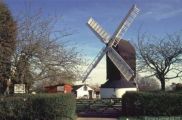
OUTWOOD IN SURREY "The Village with the Mill"
June 2013
Hornecourt Wood is an absolute joy at the best of times but particularly so this year as a result of a long cold winter and early spring which held back plant growth. However, when the weather finally started warming at the end of April and into the early part of May, trees and shrubs began coming into leaf and flowers were everywhere, so that by mid May, Hornecourt Wood was ablaze with colour, particularly the almost indefinable hue of the bluebells. Are they blue or purple or violet? No - I think they have a colour all of their own and the best description for it has to be bluebell. The flower consists of up to twelve bells, which hang down on one side of the stem and are fringed with the upturned ends of petals which make them look like miniature dance dresses. One of the other great attributes of this flower is the unmistakeable sweet, musky scent which hangs on the air. Elsewhere, along the woodland paths, there were violets interspersed with pale yellow primroses, white dead-nettles and their close relative the yellow dead nettle, also known as archangel and patches of wood spurge (Euphorbia amaygdaloides) with heads of small, golden chartreuse coloured flowers. They are small delicate looking plants but care needs to be taken in handling them because if a stem is broken they produce a milky sap which if it gets on the skin can cause a rash and irritation. Another woodland gem which is worth seeking out is the woodland buttercup or little buttercup (Ranunculus uncinata) which, as the name implies, is much smaller and in many ways more beautiful than its heavyweight cousins such as the meadow and creeping buttercup. Yet another flower that chooses the edges of woodland pathways is the yellow pimpernel, a member of the same family as the primula and a close relative of creeping jenny. Other finds photographed in the wood have come from Debbie Hubbard who spotted an early purple orchid and Mary Baldock who found a wood anemone which she said "was a giant about twice the normal size" and from a distance she thought it was tulip.
By the middle of May the new leaves of deciduous trees and shrubs had opened up in myriad shades of green. One stunning example was the oak tree standing on the north side of the junction of Prince of Wales Road with Crab Hill Lane which was draped in its new leaves and with the sun shining through looked as though it was covered in a cloak of lime green velvet. Interestingly this is a red oak (Quercus rubra), a native of North America, which has leaves that are much larger than our native species with pointed rather than rounded lobes that turn a brilliant red in the autumn.
May-time is of course the time for blossom. Blackthorn was in bloom at the same time as the plums and damsons, which were followed, at the end of the third week of the month, by hawthorn in the white and pink forms, the wild cherry or gean (Prunus avium) a large specimen of which can be seen on the eastern edge of Hornecourt, and apples including both the wild crabs and our garden varieties. So far this spring there has been little sign of honeybees but buff tailed and red tailed bumble bees have thankfully been busy at work and hopefully, if the weather is reasonable this summer, we should finish up with some good crops of fruit and berries.
Mike Johnson